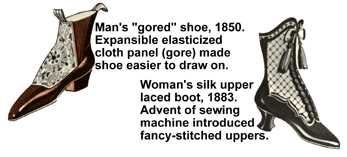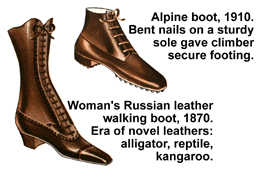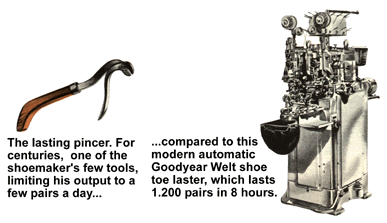
THE HISTORY OF YOUR SHOES
SHOE HISTORY
There is much evidence that a foot covering was one of the first things made by our primitive ancestors. Necessity compelled them to invent some method of protecting their feet from the jagged rocks, burning sands, and rugged terrain over which they ranged in pursuit of food and shelter.
The history of human development shows that the importance of protecting the foot was early recognized. Records of the Egyptians, the Chinese and other early civilizations all contain references to shoes. The shoe is repeatedly mentioned in the Bible and the Hebrews used it in several instances with a legal significance, notably in binding a bargain.
Shoes of one sort or another are rich in legend and figure conspicuously in the folklore of different races. The shoe, even up to the present time, continues to figure in those stories, which have come down to us. The stories of the wonderful Seven League Boots, Mercury's Winged Sandals, Puss in Boots, Cinderella, and others, all existed in some ancient and often nearly forgotten tongue, but are still well known to all children. The custom of throwing the shoe after the newly wedded couple is but one of the many instances in which the shoe, when used according to formula, was supposed to bring luck.
In its first form the shoe was just a simple piece of plaited grass or rawhide which was strapped to the feet. Among the relics of early Egyptians are some sandals made from plaited papyrus leaves, beautifully and artistically wrought. Records show that sandalmaking had become a well-recognized art early in the history of that country.
The sandal still is the most generally worn type of footwear in many warm countries. In form and ornamentation it reflects the environment in which it was worn, together with the artistic tastes of the peoples. In some countries the sandal continues to be the same simple kind worn since the dawn of history, while in others the multiple form of the straps and beautiful decorative work reflect the artistry, progress and prosperity of the wearers.
The Japanese, long a sandal wearing people indicated the social status of the wearer by making distinctive sandals for the Imperial Household, merchants and actors, in fact, for the whole range of vocations and professions.
The Greeks emphasized design and beauty, while the Romans devised a military type of sandal that enabled their legions to travel on foot throughout the then known world. In the more luxurious days of the late Empire the sandals were often beautifully wrought with ornaments of gold and precious stones.
The moccasin is the foot protection of cold countries. The puckered seam which outlines the forepart of the moccasin is all that remains of the puckering string once gathered and tied about the ankle. This peculiar seam still appears in the footwear of people in every cold county. The moccasin of the North American Indian, the Eskimo, and the Laplander all have it.
The shoe has always had an important place in costume. Until recent years, many shoes were made to be worn only on occasions of great ceremony. Some of these were very lavish in design and ornament, lending importance and distinction to the official dress of proud wearers.
Through all this development, comparatively little attention was devoted to fitting qualities or comfort. When the medieval guilds controlled craftsmanship in Europe, perfection in workmanship and extravagance in style seems to have been sought in shoes rather than foot comfort and protection.
Among the more conspicuous oddities of style in this period was the peaked shoe or Crackow, with a toe so long that it made walking difficult if not impossible and the passage of laws to prohibit its wearing was necessary before it was discontinued. It was followed by the Duckbill shoe in Elizabethan times. Laws were enacted limiting its maximum width to 51/2 inches. These footwear oddities in turn were followed by a succession of fantastic creations and shapes.
As late as 1850 most shoes were made on absolutely straight lasts, there being no difference between the right and the left shoe. Breaking in a new pair of shoes was not easy. There were but two widths to a size; a basic last was used to produce what was known as a "slim" shoe. When it was necessary to make a "fat" or "stout" shoe the shoemaker placed over the cone of the last a pad of leather to create the additional foot room needed.
Up to 1850 all shoes were made with practically the same hand tools that were used in Egypt as early as the 14th century B.C. as a part of a sandal maker's equipment. To the curved awl, the chisel-like knife and the scraper, the shoemakers of the thirty-three intervening centuries had added only a few simple tools such as the pincers, the lapstone, the hammer and a variety of rubbing sticks used for finishing edges and heels.
Efforts had been made to develop machinery for shoe production. They had all failed and it remained for the shoemakers of the United States to create the first successful machinery for making shoes.
In 1845 the first machine to find a permanent place in the shoe industry came into use. It was the Rolling Machine, which replaced the lapstone and hammer previously used by hand shoemakers for pounding sole leather, a method of increasing wear by compacting the fibres.
This was followed in 1846 by Elias Howe's invention of the sewing machine. The success of this major invention seems to have set up a chain reaction of research and development that has gone on ever since. Today there are no major operations left in shoemaking that are not done better by machinery than formerly by hand.
In 1858, Lyman R.Blake, a shoemaker, invented a machine for sewing the soles of shoes to the uppers.His patents were purchased by Gordon McKay, who improved upon Blake's invention. The shoes made on this machine came to be called "McKays." During the Civil War, many shoemakers were called into the armies, thereby creating a serious shortage of shoes for both soldiers and civilians. The introduction of the Mckay was speeded up in an effort to relieve the shortage.
Even when McKay had perfected the machines, he found it very difficult to sell them. He was on the point of giving up since he had spent all the money he could spare, when he thought of a new plan. He went back to the shoemakers who had laughed at the idea of making shoes by machinery, but who needed some means of increased production. He told them that he would put the machines in their factories, if they would pay him a small part of what the machine would save on each pair.
McKay issued "Royalty Stamps", representing the payments made on the machine-made shoes. This method of introducing machines became the accepted practice in the industry. Mention is made of it because it had two important bearings on the industry. First, shoe manufacturers were able to use machinery without tying up large sums of money. This meant that, in the event a new shoe style suddenly became popular and called for major changes in shoe construction methods and production equipment, the manufacturer wasn't left with a huge investment in machinery made obsolete by these changes - nor with the prospect of further investment for new machines. Second, it developed a type of service which has proven to be of great value in the shoe and other industries.
This unique service was used in the shoe industry long before it spread to other industries. McKay quickly found that in order to ensure payment for the use of the machines it was necessary to keep them in operation. A machine which wasn't working did not earn any money for Mckay. He therefore made parts interchangeable and organized and trained a group of experts who could be sent wherever machines needed replacement of parts or adjustment.
In 1875 a machine for making a different type of shoe was developed. Later known as the Goodyear Welt Sewing Machine, it was used for making both Welt and Turn shoes. These machines became successful under the management of Charles Goodyear, Jr., the son of the famous inventor of the process of vulcanizing rubber.
Following McKay's example, Goodyear's name became associated with the group of machinery which included the machines for sewing Welt an Turn shoes and a great many auxiliary machines which were developed for use in connection with them.
Invention as a product of continuous research has progressed at an almost incredible pace ever since. This has required great sums of money, sometimes more than a million dollars, to perfect one shoemaking machine, and tireless patience and effort. Inventors have often mechanized hand operations that seemed impossible for any machine.
We have progressed along way from the lasting pincer, a simple combination of gripper and lever. For centuries it was the hand shoemaker's only tool for shaping the shoe around the form on which it is made - aided only by his thumbs and tacks, The lasting pincer is a good tool and is still occasionally useful; with it a century ago a man with great effort might form or last a few pair in a long day. Today's automatic toe laster for Goodyear Welt shoes can last 1.200 pairs in an 8-hour day.
SOURCE: "How American Shoes are Made" with the permission of United Shoe Machinery Corporation.
























